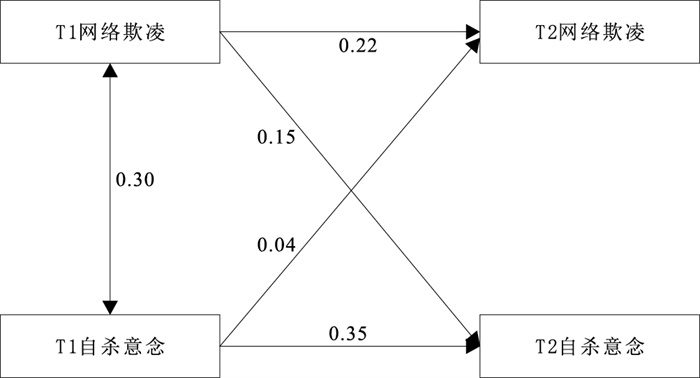The cross-lagged study between cyberbully and suicidal ideation among college students
-
摘要:
目的 了解网络欺凌与大学生自杀意念的因果关系及内在发生机制,为有效干预大学生自杀行为提供纵向证据。 方法 基于一般压力理论,采用纵向设计,使用受网络欺凌行为问卷、自杀意念量表以及流调用抑郁自评量表(CES-D)对北京市和西安市4所高校的558名大学生进行2次追踪测试,建构以抑郁为中介的交叉滞后模型。 结果 交叉滞后分析结果表明,前期网络欺凌正向预测了后期大学生的抑郁症状和自杀意念(β值分别为0.06,0.15,P值均 < 0.01),且前期抑郁正向预测后期自杀意念(β=0.29,P < 0.01);前期抑郁在前期网络欺凌与后期大学生自杀意念之间发挥中介效应。跨群组分析显示,网络欺凌、抑郁与自杀意念之间的纵向中介关系存在性别差异,即女生比男生更易受到网络欺凌的影响,且更易产生抑郁情绪与自杀意念。 结论 网络欺凌与大学生自杀意念之间存在纵向因果关系,依据性别干预大学生的抑郁情绪对自杀行为具有一定的实践意义。 Abstract:Objective To provide longitudinal evidence for interventions in suicidal behavior among college students, this study explored the mechanisms underlying the relationship between cyberbully. Methods Based on the general strain theory, 558 college students from Beijing and Xi'an were followed up 2 times(T1 and T2) by using the Cyberbullying Questionnaire, Beck Scale for Suicide Ideation and Center for Epidemiological Survey-Depression Scale(CES-D). Results T1 cyberbully could positively predict depression and suicidal ideation among college students at T2(β=0.06, 0.15, P < 0.01), and depression at T1 could positively predict suicidal ideation among college students at T2(β=0.29, P < 0.01). The mediation effect revealed that depression at T1 could mediate the relationship between cyberbully and suicidal ideation. Compared to boys, girls were likely to be affected by cyberbully and resulted in depression and suicidal ideation. Conclusion Findings contribute to the prespective causal relation between cyberbullying and suicidal ideation among college students and provide the longitudinal evidence for intervention of suicidal ideation. -
Key words:
- Internet /
- Violence /
- Suicide /
- Mental health /
- Students
1) 利益冲突声明 所有作者声明无利益冲突。 -
表 1 大学生网络欺凌与自杀意念及抑郁的相关系数(n=558,r值)
Table 1. Correlations between Internet bullying and suicidal ideation depression in college students(n=558, r)
变量 T1网络欺凌 T2网络欺凌 T1自杀意念 T2自杀意念 T1抑郁 T2网络欺凌 0.65 T1自杀意念 0.25 0.23 T2自杀意念 0.17 0.22 0.58 T1抑郁 0.22 0.21 0.50 0.37 T2抑郁 0.15 0.19 0.35 0.51 0.40 注:P值均 < 0.01。 表 2 男生与女生的交叉滞后模型结果比较
Table 2. Comparative results of cross-lagged model between boy and girl
模型 模型拟合 模型比较 χ2值 df CFI TLI RMSEA AIC EVIC Δχ2值 Δdf P值 模型3自由估计 306.79 6 0.98 0.94 0.02 396.79 0.47 模型4结构加权模型 332.89 14 0.98 0.95 0.02 394.12 0.23 25.98 8 < 0.05 模型5结构协方差模型 348.43 26 0.97 0.94 0.03 547.43 0.32 41.64 20 < 0.05 -
[1] MENG S, QI J, YIN P, et al. Suicide mortality China, 2018[J]. Chin CDC Weekly, 2020, 2(36): 694-695. doi: 10.46234/ccdcw2020.192 [2] PHILLIPS M R, LI X, ZHANG Y. Suicide rates in China, 1995-99[J]. Lancet, 2002, 359(9309): 835-840. doi: 10.1016/S0140-6736(02)07954-0 [3] XING X Y, TAO F B, WAN Y H, et al. Family factors associated with suicide attempts among Chinese adolescent students: a national cross-sectional survey[J]. J Adolesc Health, 2010, 46(6): 592-599. doi: 10.1016/j.jadohealth.2009.12.006 [4] KLONSKY E D, MAY A M. The three-step theory (3ST): a new theory of suicide rooted in the "ideation-to-action" framework[J]. Cogn Ther, 2015, 8(2): 114-129. doi: 10.1521/ijct.2015.8.2.114 [5] KOWALSKI R M, GIUMETTI G W, SCHROEDER A N, et al. Bullying in the digital age: a critical review and Meta-analysis of cyberbullying research among youth[J]. Psychol Bull, 2014, 140(4): 1073-1137. doi: 10.1037/a0035618 [6] HINDUJA S, PATCHIN J W. Bullying, cyberbullying, and suicide[J]. Arch Suic Res, 2010, 14(3): 206-221. doi: 10.1080/13811118.2010.494133 [7] WANG J, NANSEL T R, IANNOTTI R J. Cyber and traditional bullying: differential association with depression[J]. J Adolesc Health, 2011, 48(4): 415-417. doi: 10.1016/j.jadohealth.2010.07.012 [8] 尚玉秀, 董桂清, 刘婷. 银川市大学生自杀意念及抑郁影响因素分析[J]. 中国公共卫生, 2008, 24(8): 934-936. https://www.cnki.com.cn/Article/CJFDTOTAL-ZGGW200808018.htmSHANG Y X, DONG G Q, LIU T. Analysis on prevalence of suicidal ideation and depression and its influence factors among undergraduate students in Yinchuan[J]. Chin J Public Health, 2008, 24(8): 934-936. https://www.cnki.com.cn/Article/CJFDTOTAL-ZGGW200808018.htm [9] 尤阳. 受网络欺凌行为问卷的修订及其影响因素的分析[D]. 金华: 浙江师范大学, 2013.YOU Y. Revising Scale for Cyberbullying Victims' Behaviors and analyzing the influential factors[D]. Jinhua: Zhejiang Normal University, 2013. [10] BECK A T, KOVACS, M, WEISSMAN A. Assessment of suicidal intention: the Scale for Suicide Ideation[J]. J Consult Clin Psychol, 1979, 47(2): 343-352. doi: 10.1037/0022-006X.47.2.343 [11] RADLOFF L S. The CES-D scale: a self-report depression scale for research in the general population[J]. Appl Psychol Meas, 1977, 1(3): 385-401. doi: 10.1177/014662167700100306 [12] CROSS D, BARNES A, PAPAGEORGIOU A, et al. A social-ecological framework for understanding and reducing cyberbullying behaviours[J]. Aggress Viol Behav, 2015, 2: 109-117. [13] NOTAR C E, PADGETT S, RODEN J. Cyberbullying: resources for intervention and prevention[J]. Univ J Educ Res, 2013, 1(3): 133-145. doi: 10.13189/ujer.2013.010301 [14] DEN HAMER A H, KONIJN E A. Adolescents' media exposure may increase their cyberbullying behavior: a longitudinal study[J]. J Adolesc Health, 2015, 56(2): 203-208. doi: 10.1016/j.jadohealth.2014.09.016 [15] LEE M S, ZI-PEI W, SVANSTRÖM L, et al. Cyber bullying prevention: intervention in Taiwan[J]. PLoS One, 2013, 8(5): e64031. doi: 10.1371/journal.pone.0064031 -







 下载:
下载:




